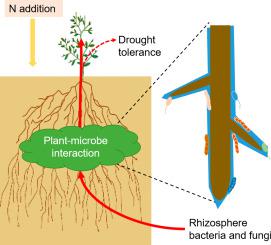Applied Soil Ecology ( IF 4.8 ) Pub Date : 2021-02-22 , DOI: 10.1016/j.apsoil.2021.103940 Zhihao Zhang , Akash Tariq , Fanjiang Zeng , Corina Graciano , Feng Sun , Xutian Chai , Zeeshan Ahmed

|
Rhizosphere microbes are key regulators of phreatophyte establishment in extremely arid environments. Although it is known that increased nitrogen (N) deposition alters microbial communities in arid lands, the effect of N enrichment in soil on phreatophyte rhizospheric microbes remain poorly understood. In a mesocosms experiment, we characterized the diversity, composition of rhizospheric bacterial and fungal communities of Alhagi sparsifolia seedlings by high-throughput sequencing in four-level N additions under drought and well-watered regimes. The relationships between microbial communities and soil properties and plant traits were also quantified. N interacted with water explained the 42.1% variation on fungal community composition, and significantly altered their alpha-diversity which positively correlated with proline accumulation in leaves, while the rhizobacterial community exhibited stability to N and water inputs. The Mantel test showed that microbial community composition at the OTU level was interrelated to soil properties and plant traits. Co-occurrence network analyses suggested that low N input (0–3 g m−2 year−1) and drought stress caused more complex associations along with vulnerability to environmental interference. Our results proposed that rhizosphere bacterial and fungal communities of phreatophyte respond differently to N enrichment under divergent water regimes. Climate change could potentially affect desert plant-microbe interactions. These findings can contribute to predicting and managing ecological and evolutionary responses of the desert ecosystem under global changing scenarios.
中文翻译:

氮和水的添加调节杂草幼苗根际的真菌群落和微生物共生网络的复杂性
在极端干旱的环境中,根际微生物是藻类植物建立的关键调节剂。尽管众所周知,增加的氮(N)沉积会改变干旱土地上的微生物群落,但是土壤中氮的富集对植物真菌根际微生物的影响仍然知之甚少。在一个中观实验中,我们表征了Alhagi sparsifolia的根际细菌和真菌群落的多样性,组成在干旱和水源充足的条件下,通过高通量测序在四级氮添加下对幼苗进行处理。还量化了微生物群落与土壤特性和植物性状之间的关系。氮与水的相互作用解释了真菌群落组成的42.1%变化,并显着改变了其α多样性,这与叶片中脯氨酸的积累呈正相关,而根际细菌群落对氮和水分输入表现出稳定性。Mantel试验表明,OTU级别的微生物群落组成与土壤特性和植物性状相关。共现网络分析表明,低氮输入(0–3 g m - 2 年-1)和干旱压力导致更复杂的关联以及对环境干扰的脆弱性。我们的研究结果表明,在不同的水环境下,根真菌的细菌和真菌群落对藻类植物的氮富集反应不同。气候变化可能会影响沙漠植物与微生物的相互作用。这些发现可有助于预测和管理全球变化场景下沙漠生态系统的生态和进化响应。











































 京公网安备 11010802027423号
京公网安备 11010802027423号